
Postage stamps and postal history of Germany
Encyclopedia
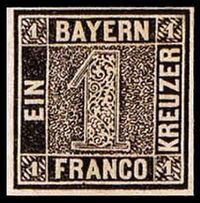
Postal history
Postal history is the study of postal systems and how they operate and, or, the study of postage stamps and covers and associated material illustrating historical episodes of postal systems...
of Germany and philatelically
Philately
Philately is the study of stamps and postal history and other related items. Philately involves more than just stamp collecting, which does not necessarily involve the study of stamps. It is possible to be a philatelist without owning any stamps...
related areas. The main modern providers of service were the Reichspost
Reichspost
- Imperial Reichspost :* The Imperial Reichspost was the name of the postal service of the Holy Roman Empire, founded by Franz von Taxis in 1495...
(1871–1945), the Deutsche Post under Allied control (1945–1949), the Deutsche Post of the GDR
Deutsche Post of the GDR
The Deutsche Post , also Deutsche Post of the GDR was the state-owned postal and telecommunications monopoly of the German Democratic Republic...
(1949–1990), the Deutsche Bundespost
Deutsche Bundespost
The Deutsche Bundespost was created in 1947 as a successor to the Reichspost . Between 1947 and 1950 the enterprise was called Deutsche Post...
(1949–1995), along with the Deutsche Bundespost Berlin
Deutsche Bundespost Berlin
The Deutsche Bundespost Berlin was the governmental agency to provide mail and telecommunication services for West Berlin. This civil service agency was in operation from 1949 until 1990.-Historical background:...
(1949–1990), and are now the Deutsche Post AG
Deutsche Post
Deutsche Post AG, operating under the trade name Deutsche Post DHL, is the world's largest logistics group. With its headquarters in Bonn, the corporation has 467,088 employees in more than 220 countries and territories worldwide and generated revenue of € 51.48 billion in 2010...
(since 1995).
Metzger Post
The Metzger Post is credited to be perhaps the first international post of the Middle AgesMiddle Ages
The Middle Ages is a periodization of European history from the 5th century to the 15th century. The Middle Ages follows the fall of the Western Roman Empire in 476 and precedes the Early Modern Era. It is the middle period of a three-period division of Western history: Classic, Medieval and Modern...
The guild
Guild
A guild is an association of craftsmen in a particular trade. The earliest types of guild were formed as confraternities of workers. They were organized in a manner something between a trade union, a cartel, and a secret society...
of butcher
Butcher
A butcher is a person who may slaughter animals, dress their flesh, sell their meat or any combination of these three tasks. They may prepare standard cuts of meat, poultry, fish and shellfish for sale in retail or wholesale food establishments...
s (German: Metzger) organized courier mail services with horses; when the mail arrived they used a horn
Post horn
The post horn is a valveless cylindrical brass or copper instrument with cupped mouthpiece, used to signal the arrival or departure of a post rider or mail coach...
to announce it and thus created a commonly recognized emblem
Emblem
An emblem is a pictorial image, abstract or representational, that epitomizes a concept — e.g., a moral truth, or an allegory — or that represents a person, such as a king or saint.-Distinction: emblem and symbol:...
for postal services. The Metzger Post was established in the twelfth century and survived until 1637, when Thurn and Taxis's monopoly took over.
Thurn and Taxis
_1967,_minr_535.jpg)
Maximilian I, Holy Roman Emperor
Maximilian I , the son of Frederick III, Holy Roman Emperor and Eleanor of Portugal, was King of the Romans from 1486 and Holy Roman Emperor from 1493 until his death, though he was never in fact crowned by the Pope, the journey to Rome always being too risky...
of the Holy Roman Empire
Holy Roman Empire
The Holy Roman Empire was a realm that existed from 962 to 1806 in Central Europe.It was ruled by the Holy Roman Emperor. Its character changed during the Middle Ages and the Early Modern period, when the power of the emperor gradually weakened in favour of the princes...
, Franz von Taxis established a postal service that replaced the ad-hoc courier for official mail. A horse relay system was created that shortened the transit time for mail and made its arrival predictable. Thereafter, the house of Thurn and Taxis using the imperial yellow and black livery maintained the postal privilege for many centuries. Thurn and Taxis employed the first horse-drawn mail coaches in Europe since Roman times in 1650, - they started in the town of Kocs
Kocs
Kocs is a village in Komárom-Esztergom county, Hungary. It lies west of Tata and west of Budapest.-History:Kocs is best known internationally as giving rise to the English word coach and its equivalents in nearly all European languages, for example: Czech koč, German kutsche, Dutch koets,...
giving rise to the term "coach".
Thurn and Taxis lost its monopoly when Napoleon granted the Rhine Confederation the right to conduct postal services. The agency continued to operate and even issued some stamps (v.i.) but when Prussia created the North German Confederancy Thurn and Taxis had to sell its privileges in 1867.
German states
Prior to the German unification of 1871, individual German states and entities started to release their own stamps, BavariaBavaria
Bavaria, formally the Free State of Bavaria is a state of Germany, located in the southeast of Germany. With an area of , it is the largest state by area, forming almost 20% of the total land area of Germany...
first on November 1, 1849 with the one kreuzer black
One kreuzer black
The One kreuzer black, or Schwarzer Einser, was the first postage stamp issued in the kingdom of Bavaria, and the first anywhere in the territories making up modern Germany. It was issued on November 1, 1849...
. States or entities that issued stamps subsequently were Baden
Baden
Baden is a historical state on the east bank of the Rhine in the southwest of Germany, now the western part of the Baden-Württemberg of Germany....
(1851), Bergedorf
Bergedorf
Bergedorf is the largest of the seven boroughs of Hamburg, Germany and a quarter within this borough. In 2006 the population of the borough was 118,942.-History:...
(1861), Braunschweig
Braunschweig
Braunschweig , is a city of 247,400 people, located in the federal-state of Lower Saxony, Germany. It is located north of the Harz mountains at the farthest navigable point of the Oker river, which connects to the North Sea via the rivers Aller and Weser....
(1852), Bremen
Bremen
The City Municipality of Bremen is a Hanseatic city in northwestern Germany. A commercial and industrial city with a major port on the river Weser, Bremen is part of the Bremen-Oldenburg metropolitan area . Bremen is the second most populous city in North Germany and tenth in Germany.Bremen is...
(1855), Hamburg
Hamburg
-History:The first historic name for the city was, according to Claudius Ptolemy's reports, Treva.But the city takes its modern name, Hamburg, from the first permanent building on the site, a castle whose construction was ordered by the Emperor Charlemagne in AD 808...
(1859), Hannover (1850), Heligoland
Heligoland
Heligoland is a small German archipelago in the North Sea.Formerly Danish and British possessions, the islands are located in the Heligoland Bight in the south-eastern corner of the North Sea...
(1867), Lübeck
Lübeck
The Hanseatic City of Lübeck is the second-largest city in Schleswig-Holstein, in northern Germany, and one of the major ports of Germany. It was for several centuries the "capital" of the Hanseatic League and, because of its Brick Gothic architectural heritage, is listed by UNESCO as a World...
(1859), Mecklenburg-Schwerin
Mecklenburg-Schwerin
Mecklenburg-Schwerin was a duchy in northern Germany created in 1348, when Albert II of Mecklenburg and his younger brother John were raised to Dukes of Mecklenburg by King Charles IV...
(1856), Mecklenburg-Strelitz
Mecklenburg-Strelitz
Mecklenburg-Strelitz was a duchy and later grand duchy in northern Germany, consisting of the eastern fifth of the historic Mecklenburg region, roughly corresponding with the present-day Mecklenburg-Strelitz district , and the western exclave of the former Bishopric of Ratzeburg in modern...
(1864), Oldenburg
Oldenburg
Oldenburg is an independent city in Lower Saxony, Germany. It is situated in the western part of the state between the cities of Bremen and Groningen, Netherlands, at the Hunte river. It has a population of 160,279 which makes it the fourth biggest city in Lower Saxony after Hanover, Braunschweig...
(1852), Prussia
Prussia
Prussia was a German kingdom and historic state originating out of the Duchy of Prussia and the Margraviate of Brandenburg. For centuries, the House of Hohenzollern ruled Prussia, successfully expanding its size by way of an unusually well-organized and effective army. Prussia shaped the history...
(1850), Saxony
Saxony
The Free State of Saxony is a landlocked state of Germany, contingent with Brandenburg, Saxony Anhalt, Thuringia, Bavaria, the Czech Republic and Poland. It is the tenth-largest German state in area, with of Germany's sixteen states....
(1850), Schleswig-Holstein
Schleswig-Holstein
Schleswig-Holstein is the northernmost of the sixteen states of Germany, comprising most of the historical duchy of Holstein and the southern part of the former Duchy of Schleswig...
(1850), and Württemberg
Württemberg
Württemberg , formerly known as Wirtemberg or Wurtemberg, is an area and a former state in southwestern Germany, including parts of the regions Swabia and Franconia....
(1851). Also Thurn and Taxis while not a state had the authority to issue stamps and transport mail and released stamps (1852). The northern German states joined in the North German Confederation
North German Confederation
The North German Confederation 1866–71, was a federation of 22 independent states of northern Germany. It was formed by a constitution accepted by the member states in 1867 and controlled military and foreign policy. It included the new Reichstag, a parliament elected by universal manhood...
in 1868 and united their postal services in the "North German Postal District" (Norddeutscher Postbezirk). After the unification, Bavaria and Württemberg retained their postal authority to continue producing stamps until March 31, 1920.
Reichspost
The Deutsche Reichspost started officially on May 4, 1871 using initially stamps of the North German Confederation until it issued its first stamps on January 1, 1872. Heinrich von StephanHeinrich von Stephan
Heinrich von Stephan was a general post director for the German Empire who reorganized the German postal service. He was integral in the founding of the Universal Postal Union in 1874, and in 1877 introduced the telephone to Germany.Stephan was born in Stolp , Pomerania, in the Kingdom of Prussia...
, inventor of the postcard
Postcard
A postcard or post card is a rectangular piece of thick paper or thin cardboard intended for writing and mailing without an envelope....
and founder of the Universal Postal Union
Universal Postal Union
The Universal Postal Union is an international organization that coordinates postal policies among member nations, in addition to the worldwide postal system. The UPU contains four bodies consisting of the Congress, the Council of Administration , the Postal Operations Council and the...
, was the first Postmaster-General. The most common stamps of the Reichspost were the Germania stamps. Germania stamps were issued from 1900 until 1922 making it the longest running series in German philately with the change in the inscription from Reichspost to Deutsches Reich being the major modification during this period.
German colonies
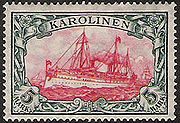
Early postage from about 1887 or 1888 consisted of common contemporary German stamps and is only recognized by the post office cancellation stamp as having been used in a colony. Such stamps are known as "Vorläufer" (forerunner
Forerunner (stamp)
In philately, a forerunner is a postage stamp used before a region or territory issued stamps of its own. The term also includes stamps of the political predecessors of a country...
) stamps. In the next step regular stamps were used with overprint
Overprint
An overprint is an additional layer of text or graphics added to the face of a postage stamp or banknote after it has been printed. Post offices most often use overprints for internal administrative purposes such as accounting but they are also employed in public mail...
s indicating the name of the territory. Generally by 1896 and thereafter overprinted stamps were issued by the German authorities for all colonies:German South West Africa, German New Guinea
German New Guinea
German New Guinea was the first part of the German colonial empire. It was a protectorate from 1884 until 1914 when it fell to Australia following the outbreak of the First World War. It consisted of the northeastern part of New Guinea and several nearby island groups...
, Kiautschou, Togo
Togo
Togo, officially the Togolese Republic , is a country in West Africa bordered by Ghana to the west, Benin to the east and Burkina Faso to the north. It extends south to the Gulf of Guinea, on which the capital Lomé is located. Togo covers an area of approximately with a population of approximately...
, Samoa
Samoa
Samoa , officially the Independent State of Samoa, formerly known as Western Samoa is a country encompassing the western part of the Samoan Islands in the South Pacific Ocean. It became independent from New Zealand in 1962. The two main islands of Samoa are Upolu and one of the biggest islands in...
, Marshall Islands
Marshall Islands
The Republic of the Marshall Islands , , is a Micronesian nation of atolls and islands in the middle of the Pacific Ocean, just west of the International Date Line and just north of the Equator. As of July 2011 the population was 67,182...
, Mariana Islands
Mariana Islands
The Mariana Islands are an arc-shaped archipelago made up by the summits of 15 volcanic mountains in the north-western Pacific Ocean between the 12th and 21st parallels north and along the 145th meridian east...
, Caroline Islands
Caroline Islands
The Caroline Islands are a widely scattered archipelago of tiny islands in the western Pacific Ocean, to the north of New Guinea. Politically they are divided between the Federated States of Micronesia in the eastern part of the group, and Palau at the extreme western end...
, German East Africa
German East Africa
German East Africa was a German colony in East Africa, which included what are now :Burundi, :Rwanda and Tanganyika . Its area was , nearly three times the size of Germany today....
and Kamerun
Kamerun
German Cameroon was a West African colony of the German Empire from 1884 to 1916 in the region of today's Republic of Cameroon.-History:-1800s:...
. By about 1900 the yacht issue
Yacht issue
The Yacht issue was a series of postage stamps, bearing the image of the German Kaiser's yacht, SMY Hohenzollern II, that were used in all of Germany's overseas colonies. Millions of the stamps were produced and they were the principal means of postage for all German imperial overseas possessions...
was introduced for the various colonial territories with had a uniform appearance depicting the imperial yacht SMY Hohenzollern
SMY Hohenzollern
SMY Hohenzollern was the name of several Yachts used by the German Emperors between 1878 and 1918, named after their House of Hohenzollern.- SMY Hohenzollern I :...
. After Germany lost control of its colonies in the course of World War I, overprinted yacht stamps were temporarily used by the new colonial rulers.
German offices abroad
Imperial Germany maintained post offices in certain towns in MoroccoMorocco
Morocco , officially the Kingdom of Morocco , is a country located in North Africa. It has a population of more than 32 million and an area of 710,850 km², and also primarily administers the disputed region of the Western Sahara...
, Turkey
Turkey
Turkey , known officially as the Republic of Turkey , is a Eurasian country located in Western Asia and in East Thrace in Southeastern Europe...
, and China. Issued stamps can be recognized by the cancellation stamp or the overprint may show local denomination and the name of the country.
German World War I occupations
During world war I, German authorities issued stamps in occupied countries, namely Belgium, Poland, Romania, and areas of the western and eastern front.Weimar Republic, 1918-1933

Reichspost
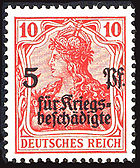
Reichspost
- Imperial Reichspost :* The Imperial Reichspost was the name of the postal service of the Holy Roman Empire, founded by Franz von Taxis in 1495...
continued to function as a governmental entity after Germany became a republic
Weimar Republic
The Weimar Republic is the name given by historians to the parliamentary republic established in 1919 in Germany to replace the imperial form of government...
. In 1919 the Reichspost issued its first commemorative
Commemorative
Commemorative may refer to:*Commemorative coin*United States Commemorative Coin*Commemorative issue - a special edition of a book, magazine, or other item released around, or in memory of, a special event or occurrence.*Commemorative stamp...
, airmail
Airmail
Airmail is mail that is transported by aircraft. It typically arrives more quickly than surface mail, and usually costs more to send...
, and semipostal
Semipostal
A semi-postal stamp or semipostal stamp, also known as a charity stamp, is a postage stamp issued to raise money for a particular purpose and sold at a premium over the postal value...
stamps. The first semipostal stamp in 1919 carried a surcharge for the benefit of war invalids (Scott #B1). In 1923 during hyperinflation
Hyperinflation
In economics, hyperinflation is inflation that is very high or out of control. While the real values of the specific economic items generally stay the same in terms of relatively stable foreign currencies, in hyperinflationary conditions the general price level within a specific economy increases...
, the Reichspost issued stamps up to 50 billion marks. The main common stamp series then was the "famous German people" series, followed by the Hindenburg
Paul von Hindenburg
Paul Ludwig Hans Anton von Beneckendorff und von Hindenburg , known universally as Paul von Hindenburg was a Prussian-German field marshal, statesman, and politician, and served as the second President of Germany from 1925 to 1934....
stamps. The first of the valuable German Zeppelin
Zeppelin
A Zeppelin is a type of rigid airship pioneered by the German Count Ferdinand von Zeppelin in the early 20th century. It was based on designs he had outlined in 1874 and detailed in 1893. His plans were reviewed by committee in 1894 and patented in the United States on 14 March 1899...
stamps appeared in 1928, Scott # C35-37.
Plebiscite areas
After the Treaty of VersaillesTreaty of Versailles
The Treaty of Versailles was one of the peace treaties at the end of World War I. It ended the state of war between Germany and the Allied Powers. It was signed on 28 June 1919, exactly five years after the assassination of Archduke Franz Ferdinand. The other Central Powers on the German side of...
a number of areas underwent plebiscites in 1920 to determine their future fate. These areas briefly issued stamps: Allenstein and Marienwerder
East Prussian plebiscite
The East Prussia plebiscite , also known as the Allenstein and Marienwerder plebiscite or Warmia, Masuria and Powiśle plebiscite , was a plebiscite for self-determination of the regions Warmia , Masuria and Powiśle, which had been in parts of East Prussia and West Prussia, in accordance with...
, Schleswig
Schleswig
Schleswig or South Jutland is a region covering the area about 60 km north and 70 km south of the border between Germany and Denmark; the territory has been divided between the two countries since 1920, with Northern Schleswig in Denmark and Southern Schleswig in Germany...
, and Upper Silesia
Upper Silesia
Upper Silesia is the southeastern part of the historical and geographical region of Silesia. Since the 9th century, Upper Silesia has been part of Greater Moravia, the Duchy of Bohemia, the Piast Kingdom of Poland, again of the Lands of the Bohemian Crown and the Holy Roman Empire, as well as of...
.
Danzig
After the Treaty of Versailles the Free City of DanzigFree City of Danzig
The Free City of Danzig was a semi-autonomous city-state that existed between 1920 and 1939, consisting of the Baltic Sea port of Danzig and surrounding areas....
was established as an independent entity in 1920. At first German stamps were still used, after a while overprinted with "Danzig". Thereafter Danzig introduced its own stamps until 1939. In addition, the Polish Post maintained a presence in Danzig and issued Port Gdansk overprinted Polish stamps.
Memel territory
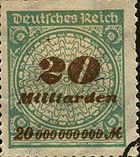
Lithuania
Lithuania , officially the Republic of Lithuania is a country in Northern Europe, the biggest of the three Baltic states. It is situated along the southeastern shore of the Baltic Sea, whereby to the west lie Sweden and Denmark...
.
Saar
After the Treaty of Versailles the SaarSaar (League of Nations)
The Territory of the Saar Basin , also referred as the Saar or Saargebiet, was a region of Germany that was occupied and governed by Britain and France from 1920 to 1935 under a League of Nations mandate, with the occupation originally being under the auspices of the Treaty of Versailles...
territory was administered by the League of Nations
League of Nations
The League of Nations was an intergovernmental organization founded as a result of the Paris Peace Conference that ended the First World War. It was the first permanent international organization whose principal mission was to maintain world peace...
. It issued its own stamps from 1920 to 1935 when it returned to Germany after a plebiscite. The first stamps were overprinted German and Bavarian stamps.
After World War II the Saar
Saar (protectorate)
The Saar Protectorate was a German borderland territory twice temporarily made a protectorate state. Since rejoining Germany the second time in 1957, it is the smallest Federal German Area State , the Saarland, not counting the city-states Berlin, Hamburg and Bremen...
territory came under French administration and issued its own stamps from 1947-1956. Following a referendum it was returned to Germany in 1956, and continued its stamps series until 1959.
Reichspost
During the "Third Reich" the Reichspost continued to function as a monopoly of the government under the auspices of the ReichspostministeriumReichspostministerium
The Reichspostministerium, during the reign of National Socialism, had authority over research and development departments in the areas of television engineering, high-frequency technology, cable transmission, metrology, and acoustics .-Formation:On 1 January 1937, Department VIII of the former...
, and Nazi propaganda
Nazi propaganda
Propaganda, the coordinated attempt to influence public opinion through the use of media, was skillfully used by the NSDAP in the years leading up to and during Adolf Hitler's leadership of Germany...
took hold and influenced stamp design and policy. The Hitler head stamp became the stamp for common usage, and a large number of semipostal
Semipostal
A semi-postal stamp or semipostal stamp, also known as a charity stamp, is a postage stamp issued to raise money for a particular purpose and sold at a premium over the postal value...
stamps were issued. In the last year before the end of the war the stamp inscription "Deutsches Reich" was changed to "Grossdeutsches Reich" (Greater German Empire). Field post stamps were issued for the military forces starting in 1942. The world's first postal code
Postal code
A postal code is a series of letters and/or digits appended to a postal address for the purpose of sorting mail. Once postal codes were introduced, other applications became possible.In February 2005, 117 of the 190 member countries of the Universal Postal Union had postal code systems...
system was introduced on July 25, 1941 with a two-digit number system. This system was initially used for the packet service and later applied to all mail deliveries.
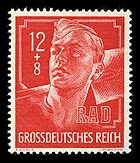
Sudeten/Bohemia and Moravia
After the Munich agreementMunich Agreement
The Munich Pact was an agreement permitting the Nazi German annexation of Czechoslovakia's Sudetenland. The Sudetenland were areas along Czech borders, mainly inhabited by ethnic Germans. The agreement was negotiated at a conference held in Munich, Germany, among the major powers of Europe without...
the Sudetenland
Sudetenland
Sudetenland is the German name used in English in the first half of the 20th century for the northern, southwest and western regions of Czechoslovakia inhabited mostly by ethnic Germans, specifically the border areas of Bohemia, Moravia, and those parts of Silesia being within Czechoslovakia.The...
became German territory in 1938 and initially, Czech stamps were used locally with an overprint, before German stamps became available. In 1939 Nazi Germany occupied part of Czechoslovakia, overprinted initially Czecholovakian stamps, and then issued stamps for Bohemia and Moravia until 1945.
German World War II occupations
During the course of World War II German authorities issues stamps in AlbaniaAlbania
Albania , officially known as the Republic of Albania , is a country in Southeastern Europe, in the Balkans region. It is bordered by Montenegro to the northwest, Kosovo to the northeast, the Republic of Macedonia to the east and Greece to the south and southeast. It has a coast on the Adriatic Sea...
, Alsace
Alsace
Alsace is the fifth-smallest of the 27 regions of France in land area , and the smallest in metropolitan France. It is also the seventh-most densely populated region in France and third most densely populated region in metropolitan France, with ca. 220 inhabitants per km²...
, Belgium
Belgium
Belgium , officially the Kingdom of Belgium, is a federal state in Western Europe. It is a founding member of the European Union and hosts the EU's headquarters, and those of several other major international organisations such as NATO.Belgium is also a member of, or affiliated to, many...
, Channel Islands
Channel Islands
The Channel Islands are an archipelago of British Crown Dependencies in the English Channel, off the French coast of Normandy. They include two separate bailiwicks: the Bailiwick of Guernsey and the Bailiwick of Jersey...
, Estland
Estland
* Estland is the modern name for Estonia in German, Swedish, Danish, Norwegian, Dutch and some other Germanic languages, with the notable exception of modern English....
, parts of France
France
The French Republic , The French Republic , The French Republic , (commonly known as France , is a unitary semi-presidential republic in Western Europe with several overseas territories and islands located on other continents and in the Indian, Pacific, and Atlantic oceans. Metropolitan France...
, Kotor
Kotor
Kotor is a coastal city in Montenegro. It is located in a secluded part of the Gulf of Kotor. The city has a population of 13,510 and is the administrative center of the municipality....
, Kurland, Latvia
Latvia
Latvia , officially the Republic of Latvia , is a country in the Baltic region of Northern Europe. It is bordered to the north by Estonia , to the south by Lithuania , to the east by the Russian Federation , to the southeast by Belarus and shares maritime borders to the west with Sweden...
, Lithuania
Lithuania
Lithuania , officially the Republic of Lithuania is a country in Northern Europe, the biggest of the three Baltic states. It is situated along the southeastern shore of the Baltic Sea, whereby to the west lie Sweden and Denmark...
, Luxembourg
Luxembourg
Luxembourg , officially the Grand Duchy of Luxembourg , is a landlocked country in western Europe, bordered by Belgium, France, and Germany. It has two principal regions: the Oesling in the North as part of the Ardennes massif, and the Gutland in the south...
, Macedonia, Montenegro
Montenegro
Montenegro Montenegrin: Crna Gora Црна Гора , meaning "Black Mountain") is a country located in Southeastern Europe. It has a coast on the Adriatic Sea to the south-west and is bordered by Croatia to the west, Bosnia and Herzegovina to the northwest, Serbia to the northeast and Albania to the...
, Poland
Poland
Poland , officially the Republic of Poland , is a country in Central Europe bordered by Germany to the west; the Czech Republic and Slovakia to the south; Ukraine, Belarus and Lithuania to the east; and the Baltic Sea and Kaliningrad Oblast, a Russian exclave, to the north...
(General Government
General Government
The General Government was an area of Second Republic of Poland under Nazi German rule during World War II; designated as a separate region of the Third Reich between 1939–1945...
), parts of Russia
Russia
Russia or , officially known as both Russia and the Russian Federation , is a country in northern Eurasia. It is a federal semi-presidential republic, comprising 83 federal subjects...
, Serbia
Serbia
Serbia , officially the Republic of Serbia , is a landlocked country located at the crossroads of Central and Southeast Europe, covering the southern part of the Carpathian basin and the central part of the Balkans...
, Slovenia
Slovenia
Slovenia , officially the Republic of Slovenia , is a country in Central and Southeastern Europe touching the Alps and bordering the Mediterranean. Slovenia borders Italy to the west, Croatia to the south and east, Hungary to the northeast, and Austria to the north, and also has a small portion of...
, Ukraine
Ukraine
Ukraine is a country in Eastern Europe. It has an area of 603,628 km², making it the second largest contiguous country on the European continent, after Russia...
, Zante, and Zara
Zara
-Places:*Zara, Turkey, district in the Turkish province of Sivas Province *Zara, Italian, Venetian, German and Hungarian name of the Adriatic port city of Zadar , former capital of Dalmatia, today in Croatia*Zara, Tibet, village in the Tibet Autonomous Region of China*Zara ,...
.
Local issues
In the process of the collapse of Nazi Germany, mail services became disrupted or ceased. Various communities established services locally during the void often using defaced Hitler stamps.Allied occupation
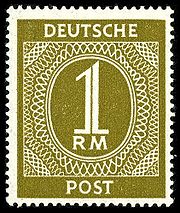
Baden
Baden is a historical state on the east bank of the Rhine in the southwest of Germany, now the western part of the Baden-Württemberg of Germany....
, Rheinland-Pfalz, and Württemberg
Württemberg
Württemberg , formerly known as Wirtemberg or Wurtemberg, is an area and a former state in southwestern Germany, including parts of the regions Swabia and Franconia....
. In addition, separate stamps were provided for the Saar
Saar (protectorate)
The Saar Protectorate was a German borderland territory twice temporarily made a protectorate state. Since rejoining Germany the second time in 1957, it is the smallest Federal German Area State , the Saarland, not counting the city-states Berlin, Hamburg and Bremen...
. In the Soviet zone, initially in 1945, various provinces released different stamps, namely Berlin-Brandenburg
Brandenburg
Brandenburg is one of the sixteen federal-states of Germany. It lies in the east of the country and is one of the new federal states that were re-created in 1990 upon the reunification of the former West Germany and East Germany. The capital is Potsdam...
, Mecklenburg-Vorpommern, Saxonia
Saxonia
Saxonia may refer to:* Saxonia, the Latin name of Saxony* Saxonia , the allegorical representation of Saxony* Saxonia , first locomotive built in Germany in 1838, more than one passenger ship of the Cunard Line...
(Ost Sachsen, West Sachsen, Provinz Sachsen), and Thuringia
Thuringia
The Free State of Thuringia is a state of Germany, located in the central part of the country.It has an area of and 2.29 million inhabitants, making it the sixth smallest by area and the fifth smallest by population of Germany's sixteen states....
. In 1946, German stamps were issued as Deutsche Post for the American, British, and Soviet zones but not the French zone. The typical yellow color to signify post service was decreed by the Allied Control Council
Allied Control Council
The Allied Control Council or Allied Control Authority, known in the German language as the Alliierter Kontrollrat and also referred to as the Four Powers , was a military occupation governing body of the Allied Occupation Zones in Germany after the end of World War II in Europe...
in 1946. With the development of the Cold War, however, attempts to unify the postal system failed, - the common stamps were replaced by 1948 by definitives for the Soviet zone, and different sets of stamps for the bizone
Bizone
The Bizone, or Bizonia was the combination of the American and the British occupation zones in 1947 during the occupation of Germany after World War II. With the addition of the French occupation zone in March 1948, the entity became the Trizone...
, already prior to the establishment of the two German republics.
Deutsche Bundespost Berlin
West BerlinWest Berlin
West Berlin was a political exclave that existed between 1949 and 1990. It comprised the western regions of Berlin, which were bordered by East Berlin and parts of East Germany. West Berlin consisted of the American, British, and French occupation sectors, which had been established in 1945...
under the jurisdiction of the three western powers started to release its own stamps on September 3, 1948. It continued to emit stamps under the Deutsche Bundespost Berlin label for 42 years, a total of over 800 different stamps, until the reunification in 1990. Many Berlin stamps were similar to the stamps of West Germany. West German and Berlin stamps could be used in either jurisdiction.
Deutsche Post of the GDR
With the formation of the German Democratic RepublicGerman Democratic Republic
The German Democratic Republic , informally called East Germany by West Germany and other countries, was a socialist state established in 1949 in the Soviet zone of occupied Germany, including East Berlin of the Allied-occupied capital city...
(GDR) the Deutsche Post of the GDR service was established as the governmental agency to provide mail services. Its first stamp was released on October 9, 1949. The production of these often beautiful stamps was prolific, about 3,000 different stamps were produced during the life of the existence of the DP, relatively low, however, was the number of semipostals. Stamps were to some degree used to gain currency abroad, that is some stamps were not produced for circulation but sold directly to stamp dealers. Also, for some sets a specific stamp was produced at an intentionally low number - called a "Sperrwert" (lit. blocked stamp value, or stamp with limited release) - to artificially increase the value and sell it for more money to stamp dealer
Stamp dealer
A stamp dealer is a company or an individual who deals in postage stamps and philatelic products. It also includes individuals who sell postage stamps for day to day use or official stamps for use on court documents.-Stamps on Approval Basis:...
s. With the 1990 reunification, the Deutsche Post became part of the ’’Deutsche Bundespost’’.
Deutsche Bundespost
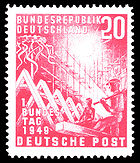
Postal code
A postal code is a series of letters and/or digits appended to a postal address for the purpose of sorting mail. Once postal codes were introduced, other applications became possible.In February 2005, 117 of the 190 member countries of the Universal Postal Union had postal code systems...
was replaced with a four-digit code., this was replaced after the reunification. By the time of the reunification about 1,400 different stamps had been issued. The process of converting the governmental agency into a public company was initiated in 1989 by separating postal services from post bank and communication services.
After the unification 1990
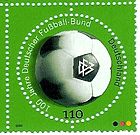
Deutsche Post AG
With the German reunificationGerman reunification
German reunification was the process in 1990 in which the German Democratic Republic joined the Federal Republic of Germany , and when Berlin reunited into a single city, as provided by its then Grundgesetz constitution Article 23. The start of this process is commonly referred by Germans as die...
, the Bundespost with the incorporated Deutsche Post of the GDR provided postal services for the whole territory of the Federal Republic, and German stamps regardless of origin were postally valid until their date of expiration: for the stamps of the GDR Mi # 1004-3343 this was October 1, 1990, and for GDR Mi 3344-3365 December 12, 1991., the latter was the same date for the expiration of the West Berlin stamps Mi #326-879. By 1993 a new five-digit postal code had been introduced. In 1995 the Bundespost was converted into a stock company, the ’’Deutsche Post AG’’ the shares of which became available in 2000. The company with its subsidiaries operates in logistics
Logistics
Logistics is the management of the flow of goods between the point of origin and the point of destination in order to meet the requirements of customers or corporations. Logistics involves the integration of information, transportation, inventory, warehousing, material handling, and packaging, and...
on a global scale.
Statistics
According to the Scott catalogueScott catalogue
The Scott catalogue of postage stamps, published by Scott Publishing Co, a subsidiary of Amos Press, is updated annually and lists all the stamps of the entire world which its editors recognize as issued for postal purposes. It is published in six large volumes and is also produced in...
, the following number of different stamps (regular and semipostal) were issued by the Reichspost (1871-1945), Deutsche Post (GDR) (1949-90), Deutsche Bundespost Berlin (1949-90), and Deutsche Bundespost (1949-90):
| Postal Authority | Regular stamps issued | Semipostals issued | Combined |
|---|---|---|---|
| Reichspost Reichspost - Imperial Reichspost :* The Imperial Reichspost was the name of the postal service of the Holy Roman Empire, founded by Franz von Taxis in 1495... |
556 | 293 | 849 |
| Deutsche Post (GDR) | 2,805 | 191 | 2,996 |
| Deutsche Bundespost Berlin Deutsche Bundespost Berlin The Deutsche Bundespost Berlin was the governmental agency to provide mail and telecommunication services for West Berlin. This civil service agency was in operation from 1949 until 1990.-Historical background:... |
592 | 285 | 877 |
| Deutsche Bundespost Deutsche Bundespost The Deutsche Bundespost was created in 1947 as a successor to the Reichspost . Between 1947 and 1950 the enterprise was called Deutsche Post... |
955 | 395 | 1,350 |
| Totals | 4,908 | 1,164 | 6,072 |

